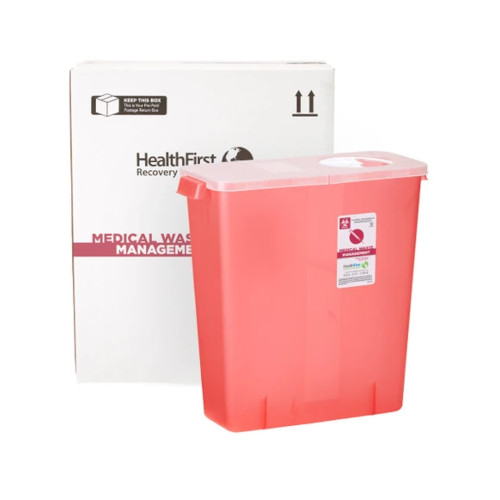Browsing Safety And Security: The Important Guide to Medical Waste Disposal Finest Practices
Exploring Different Garbage Disposal Options for a Cleaner Atmosphere
In the quest of a cleaner environment, the monitoring of waste disposal has arised as a critical focal point for sustainable advancement. With a wide range of waste disposal choices available, varying from standard land fill approaches to ingenious waste-to-energy modern technologies, the option of just how we manage our waste has significant effects for our earth's wellness.
Recycling Approaches
Applying reliable reusing techniques is crucial in decreasing waste and advertising sustainability in our setting. Recycling includes the procedure of transforming waste materials right into multiple-use things to stop unnecessary disposal. Among the most typical recycling approaches is worldly recovery, where materials like paper, metal, glass, and plastic are accumulated, arranged, and processed to develop new items. This process not only preserves natural resources yet also decreases power usage and greenhouse gas emissions connected with producing brand-new products from scratch.
An additional vital recycling method is composting, which entails decomposing organic waste like food scraps and backyard trimmings into nutrient-rich dirt. By incorporating these different recycling approaches right into our waste administration practices, we can dramatically minimize our ecological footprint and move towards an extra sustainable future.

Composting Strategies
Effective waste monitoring techniques, such as reusing approaches, lead the way for a cleaner setting, and currently, changing the focus to 'Composting Techniques', we discover lasting methods to break down organic waste for environmental advantage. medical waste removal.
Composting is an all-natural process that changes natural waste, like food scraps and yard trimmings, right into a nutrient-rich dirt modification. The key to successful composting depends on developing the best equilibrium of environment-friendly products, such as vegetables and fruit scraps, and brownish products, like dried fallen leaves and twigs. These products disintegrate with the assistance of microbes, damaging down the waste into beneficial garden compost.
There are numerous composting strategies available to match different requirements. Standard yard composting entails layering natural materials in a container or stack and on a regular basis turning the blend to aerate it. Vermicomposting, on the other hand, makes use of worms to break down raw material into garden compost (click here). For those with minimal room, interior composting systems offer a hassle-free solution. By making use of composting strategies, we can decrease the quantity of waste sent to land fills while developing a beneficial item for enriching soil and sustaining plant development.
Incineration Disadvantages and pros
Incineration, as a waste disposal approach, presents both advantages and disadvantages that warrant careful factor to consider in the world of lasting waste management practices. On the favorable side, incineration can considerably decrease the volume of waste, reducing the demand for land fill space and potentially lowering greenhouse gas exhausts. Incineration additionally enables the recovery of energy with the generation of electricity or warm, adding to resource healing. In addition, the process can be utilized to destroy unsafe materials, using a safe approach for dealing with specific types of waste that may position threats to public wellness and the setting if left unattended.
Additionally, the high preliminary investment and operational costs of incineration facilities position economic challenges, making it a much less cost-effective option compared to other waste administration approaches. Careful surveillance and guideline are necessary to alleviate these site link unfavorable effects and optimize the advantages of incineration as component of an extensive waste management strategy.
Landfill Administration Approaches
Garbage dumps play a critical role in waste monitoring and ecological preservation by giving a control system for the disposal of strong waste products. By condensing the waste, the quantity is minimized, enabling for more waste to be accommodated over time.
Additionally, the implementation of day-to-day cover techniques is vital in lessening smells, preventing litter, and reducing the attraction of parasites. Covering the disposed waste at the end of every day aids to consist of odors and protect against potential environmental contamination. In addition, the tracking of land fill gas discharges and leachate degrees is vital in making sure that environmental standards are satisfied which any kind of prospective risks to surrounding communities are reduced.

Waste-to-Energy Technologies
Among the cutting-edge methods to squander management entails harnessing Waste-to-Energy technologies to convert strong waste into usable power sources. Waste-to-Energy (WtE) innovations include a series of processes that aim to extract power from waste products through thermal, chemical, or organic methods. This conversion process not just minimizes the quantity of waste that ends up in land fills however also creates important energy sources such as electricity, heat, or biofuels.
There are several approaches of Waste-to-Energy conversion, including gasification, pyrolysis, and incineration. Incineration involves shedding waste at heats to generate warm and electrical energy. Gasification transforms waste into a syngas, which can be utilized for power generation or chemical manufacturing. Pyrolysis breaks down natural products making use of heats in the absence of oxygen, producing bio-oil, gas, and char.
Carrying out Waste-to-Energy innovations can aid mitigate ecological issues connected with traditional waste disposal methods while simultaneously supplying a sustainable power resource. However, mindful consideration should be provided to exhausts control and making sure the sustainability of feedstock materials for these technologies to be genuinely advantageous for a cleaner setting.

Verdict
In verdict, exploring numerous garbage disposal choices such as recycling, composting, incineration, landfill management, and waste-to-energy innovations is crucial for promoting a cleaner environment - click here. Each approach has its very own advantages and challenges, but by utilizing a combination of these approaches, we can function towards decreasing the quantity of waste that winds up in garbage dumps and eventually add to an extra sustainable future for generations ahead
With a plethora of waste disposal options readily available, ranging from standard garbage dump techniques to ingenious waste-to-energy technologies, the selection of just how we handle our waste has significant implications for our planet's health. medical waste removal.Incineration, as a waste disposal technique, offers both advantages and negative aspects that merit mindful factor to consider in the world of sustainable waste monitoring methods.Land fills play a crucial function in waste administration and ecological conservation by supplying a control system for the disposal of solid waste materials. By condensing the waste, the volume is decreased, enabling for more waste to be fit over time
One of the innovative methods to squander management includes taking advantage of Waste-to-Energy technologies to convert solid waste into functional power resources.